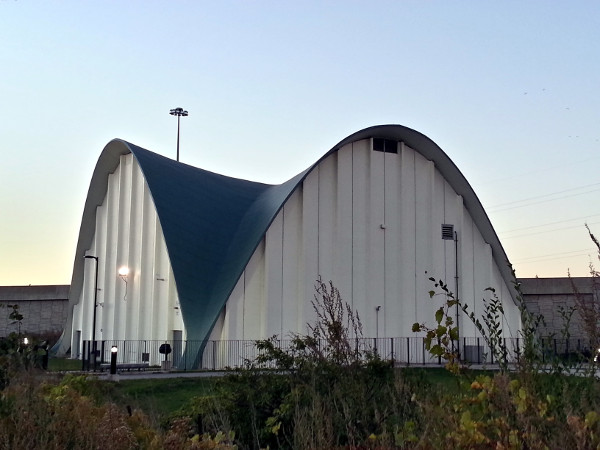There are lots of ways we can help to reduce the amount of water flowing off hard city surfaces into sewers.
By Candy Venni
Published December 02, 2015
You may recall the recent protest and news coverage regarding Hamilton Harbour. Two women spent days on a raft as a "Float-in" to point a spotlight on the terrible state of the Waterfront Trail.

Waterfront Trail (RTH file photo)
Littered with syringes, tampon applicators and other washed-up debris, it was eventually revealed that sewage had overflowed from full underground tanks due to a heavy rainstorm.
Imagine the compounded effect of rainwater coming off thousands of acres of roofs, roads and other hard surfaces, pouring into drains and sewers. The City just can't manage 2,031 kilometres of water mains, plus that much extra water flooding in all at once, efficiently.
On a positive note, the city has drastically scaled back the amount of sewage released into the harbour from combined sewers over the past two decades, spending 330 million upgrading the Woodward treatment plant and 120 million on nine more 'huge' sewage trapping tanks.

Low Lift Pumping Station, Woodward Avenue Water Treatment Plant (RTH file photo)
Unfortunately, we are rarely told when sewage does overflow into the lake unless you happen to notice signs on beaches, stating it's unsafe to swim due to high "fecal counts" (ewwww!).
There are lots of ways we can help by "getting our minds in the gutter" and reducing the amount of water flowing off hard city surfaces into sewers. The following suggestions can help put rainwater back in the soil where it can be safely absorbed.
Disconnect downspouts where it's safe to do so, then redirect water onto your own garden and create beautiful rain or bog gardens (google it) to absorb the water slowly, as nature intended.
Consider getting rain barrels with screens for watering your garden. Elevate them for a little pressure or use a hand pump to empty them out before the next big rainfall. Plants prefer rainwater over municipal water and there's a sense of satisfaction that comes from storing and using what nature gives us.
Look into permeable paving for driveways, walkways and ask/encourage local developers and politicians to advocate and do the same with parking lots.
Take steps to reduce household water use, especially during wet weather.
Ask a contractor about designing French drains or sinking perforated pipe into gravel if you have a sump pump, rather than having it hooked into your sewage pipe.
De-pave Paradise: join the growing movement to tear up asphalt in schoolyards, educate families about plant gardens and use permeable paving instead of concrete.
Start a group or team to encourage other members of the community to get involved with educational sessions as offered www.raincommunitysolutions.ca.
I was fortunate enough to grow up near ravines and waterways. Some of my fondest memories are of wading through streams, watching frogs, minnows and dragonflies. Now, as an adult, I live in Hamilton with its beautiful escarpment, waterfalls and miles of waterfront.
I know I'm not alone in the belief that we can see clear streams flowing into a pristine lake, children splashing in clean puddles, safe beaches to walk along and water we can swim in again.
By NortheastWind (registered) | Posted December 02, 2015 at 15:25:36
In my late teens (30 years ago) I worked for the MOE on their SCOUR Program (Students Cleaning Our Urban Rivers). We were cleaning Red Hill Creek one day, parked in a flood plain near Barton Street when thunderstorms hit and a torrential downpour ensued (what today would be blamed on human caused climate change). The water in the creek began to rise and within 25 minutes, the water was up by 20 feet. When we returned the next day after the water level had returned to normal, there were condoms and woman's hygiene products hanging in the trees like Christmas decorations. Fortunately since then, the combined sewer system has been separated as part of the expressway, so the sanitary flow ends up in the sewage treatment plant where it belongs. This pollution source must have added a lot of "stuff" into the Bay over the years before it was eliminated.
By JasonL (registered) | Posted December 02, 2015 at 17:42:30
I'm stunned that Hamilton continues to roll out these street reconstruction plans from the late 80's instead of updating standards in order to help create a more resilient city. I met with one of the big wigs in water/waste-water a number of years ago and I'm sure he almost fell asleep as I explained what sidewalk rain gardens/bioswales are.
We've rebuilt Concession, James N, King in Stoney Creek, Barton in Stoney Creek, West 5th and Cannon East without a SINGLE rain garden, and virtually no new trees. With all we know about urban heat island, and storm water run-off, how is this even possible?
Interestingly, there are bioswales on the West Harbour GO plaza. Not planned or designed in Hamilton. Again, something that is becoming commonplace around the continent will take decades, if ever, to appear here.
Here's what NYC has done in regards to green streets: http://www.mnn.com/earth-matters/climate...
Comment edited by JasonL on 2015-12-02 17:43:34
By RobF (registered) | Posted December 03, 2015 at 16:44:31 in reply to Comment 115317
I know the feeling. Sad, but true ... we can't seem to get our city to even reach for the low-hanging fruit it seems. This is really about reducing our infrastructure deficit by rethinking the modern infrastructural ideal and redesigning our cities to work with, rather than against, ecological processes, and getting people to think about what goes down the pipe or into the curbside storm drains. I've often wondered why we aren't demanding surface parking lots pay a tax based on square footage of asphalt cover and give a rebate if they install bioswales or permeable pavers, etc. Glad to see a piece in RTH on this important topic, and I definitely echo your sentiments Jason.
You must be logged in to comment.
There are no upcoming events right now.
Why not post one?